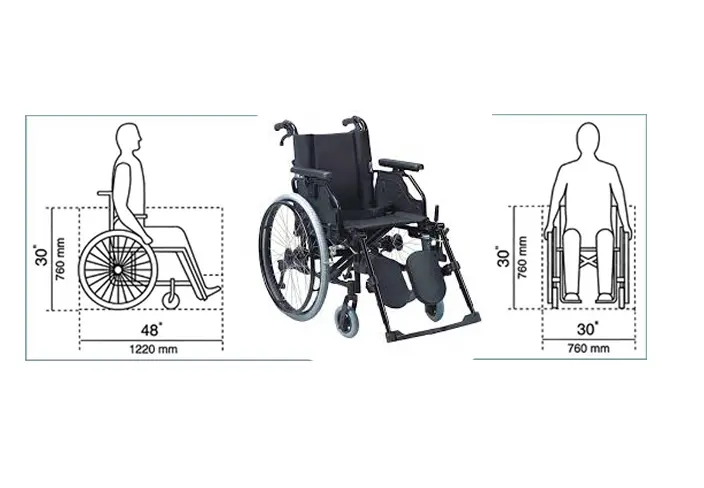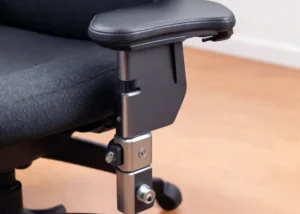
Descriptions
Wheelchairs serve as indispensable mobility aids, empowering individuals with diverse abilities to navigate the world with independence and dignity. The dimensions of a wheelchair play a pivotal role in its functionality and suitability for users’ specific needs. In this comprehensive guide, we delve into the critical aspects of wheelchair dimensions, offering insights for users, caregivers, and healthcare professionals.
Understanding Wheelchair Measurements
Wheelchair dimensions encompass various measurements crucial for ensuring a proper fit and optimal functionality. Key measurements include seat width, seat depth, back height, armrest height, and overall width. These measurements contribute to the user’s comfort, postural support, and ease of maneuverability.
Seat Width
One of the primary dimensions to consider is the seat width. This measurement is crucial for accommodating the user comfortably within the wheelchair. Standard adult wheelchair seat widths typically range from 16 to 20 inches, but customized options are available. Users should select a seat width that provides ample support without constriction.
Seat Depth
The seat depth of a wheelchair influences the user’s sitting position and overall comfort. It is measured from the front of the seat to the backrest. An appropriate seat depth ensures that the user’s legs are adequately supported and prevents pressure points. Adjustable seat depths cater to individuals with varying leg lengths, allowing for a personalized fit.
Back Height
Back height is a critical dimension that contributes to postural support and stability. The measurement extends from the seat to the top of the wheelchair backrest. Different users may have specific requirements based on their level of mobility and support needs. Higher backrests offer increased upper body support, while lower backrests provide more freedom of movement.
Armrest Height
Armrest height is essential for supporting the user’s arms comfortably. Proper armrest height promotes ergonomic posture and facilitates easy transfers. Adjustable armrests cater to individual preferences and contribute to the overall customization of the wheelchair.
Overall Width
The overall width of a wheelchair is a crucial consideration, especially when navigating through doorways and confined spaces. Standard adult wheelchairs often have an overall width ranging from 20 to 30 inches. It’s essential to choose a wheelchair width that aligns with the user’s lifestyle and the environments they frequently encounter.
Specialized Wheelchair Dimensions
Beyond standard dimensions, various specialized wheelchairs cater to specific needs. Pediatric wheelchairs are designed with smaller dimensions to ensure a proper fit for children. Bariatric wheelchairs, on the other hand, feature wider dimensions and robust frames to accommodate individuals with higher weight capacities.
Tips for Measuring Wheelchair Dimensions:
Accurate measurements are fundamental for ensuring the right wheelchair fit. Here are some tips for obtaining precise measurements:
- Use a flexible measuring tape for accurate readings.
- Measure the widest part of the body for seat width.
- Ensure that the user is seated comfortably when measuring seat depth.
- Measure from the seat to the user’s shoulder blades for back height.
- Armrest height should align with the user’s natural arm position when relaxed.
Standard wheelchair dimensions
Standard wheelchair dimensions are designed to accommodate a diverse range of users while providing comfort, support, and ease of mobility. Here are typical dimensions for a standard adult wheelchair:
Seat Width
Standard adult wheelchair seat widths typically range from 16 to 20 inches. This ensures a comfortable seating area for a variety of body sizes.
Seat Depth
The seat depth, measured from the front to the backrest, is typically around 16 to 18 inches. This dimension supports proper leg positioning and prevents pressure points.
Back Height
Standard back heights range from 16 to 20 inches, providing adequate upper body support. Some models may offer customization options for taller individuals who require additional backrest height.
Armrest Height
Armrest height is adjustable to contribute to ergonomic posture and user comfort. Standard armrest heights accommodate various preferences.
Overall Width
The overall width of a standard adult wheelchair usually ranges from 24 to 30 inches. This width allows for maneuverability through standard doorways and corridors.
It’s important to note that these dimensions serve as a general guideline, and there can be variations based on the manufacturer and wheelchair model. Additionally, wheelchairs come in various styles, including manual, power, and transport wheelchairs, each with its own set of specifications.
For users with specific needs or preferences, customization options are often available. Some wheelchairs offer adjustable features, allowing individuals to tailor the chair to their unique requirements.
Understanding standard wheelchair dimensions is crucial for selecting the right wheelchair that aligns with an individual’s body size, mobility needs, and lifestyle, ultimately enhancing their overall quality of life.
How to size a wheelchair
Sizing a wheelchair accurately is crucial to ensure optimal comfort, support, and mobility for the user. Here’s a step-by-step guide on how to size a wheelchair:
Measure Seat Width
Use a measuring tape to measure the widest part of the user’s hips.
Add a few inches (typically 2-4 inches) to allow for comfortable seating. This ensures that the user won’t feel constrained.
Determine Seat Depth
Measure from the back of the hip to the back of the knee.
Ensure that there’s a couple of inches between the edge of the seat and the back of the knee for proper leg support.
Check Back Height
Measure from the user’s waist to the top of their shoulders.
This measurement determines the appropriate backrest height for proper upper body support.
Measure Armrest Height
Measure from the seat to the user’s elbow with their arms comfortably at their sides.
This measurement helps set the armrest height for ergonomic support.
Consider Overall Width
Measure the narrowest passages the wheelchair needs to navigate, such as doorways.
Ensure that the overall width of the wheelchair is narrow enough to fit through these spaces comfortably.
Check Leg Rest Length
Measure the distance from the back of the knee to the heel of the foot.
The leg rests should be adjustable to accommodate the user’s leg length.
Assess Footrest Height
Measure from the bottom of the foot to the back of the knee.
The footrest height should be adjustable to allow for proper leg support.
Consider Weight Capacity
Ensure that the wheelchair has a weight capacity that accommodates the user’s weight comfortably. Consider potential changes in weight over time.
Consult Healthcare Professionals
Seek guidance from healthcare professionals, including physical therapists or occupational therapists, who specialize in mobility and rehabilitation.
They can provide valuable insights into the user’s specific needs and recommend appropriate wheelchair dimensions.
Test the Wheelchair
Whenever possible, have the user test the wheelchair before finalizing the purchase.
Ensure that the user feels comfortable, well-supported, and can easily maneuver the wheelchair.
Explore Customization Options
Many wheelchairs offer customization options, such as adjustable seat widths, depths, and back heights.
Explore these options to tailor the wheelchair to the user’s unique requirements.
Sizing a wheelchair involves a combination of accurate measurements, consideration of individual preferences, and expert advice. By taking the time to assess these factors, you can ensure that the wheelchair provides optimal support and enhances the user’s overall mobility experience.
Frequently Asked Questions
What is the size of a standard wheelchair?
A standard adult wheelchair typically has a seat width ranging from 16 to 20 inches, accommodating various body sizes. The seat depth, measured from front to backrest, is approximately 16 to 18 inches, ensuring proper leg support. Back heights usually range from 16 to 20 inches, offering essential upper body support. Adjustable armrest heights contribute to ergonomic comfort. The overall width of a standard wheelchair ranges from 24 to 30 inches, allowing maneuverability through standard doorways. These dimensions provide a baseline, but variations exist among models and customization options for a more personalized fit.
How wide is a wheel chair in CM?
The width of a wheelchair, measured in centimeters (cm), varies depending on the model and user specifications. A standard adult wheelchair typically has an overall width ranging from approximately 61 to 76 cm (24 to 30 inches). This dimension ensures maneuverability through standard doorways and corridors. Pediatric wheelchairs may have narrower widths to suit smaller users, often ranging from 36 to 46 cm (14 to 18 inches). It’s essential to consider these measurements for proper accessibility and comfort, and some wheelchairs offer adjustable features to accommodate individual preferences and specific needs.
How are wheelchair sizes measured?
Wheelchair sizes are measured to ensure a proper fit and optimal comfort for users. Key measurements include:
Seat Width: Measured as the widest part of the hips, providing a comfortable seating area.
Seat Depth: Measured from the front of the seat to the backrest, ensuring proper leg support.
Back Height: Measured from the seat to the top of the backrest, determining upper body support.
Armrest Height: Measured from the seat to the user’s elbow, contributing to ergonomic posture.
Overall Width: Measured to ensure maneuverability through doorways and corridors.
These measurements guide the selection and customization of wheelchairs based on individual needs.
What are the 4 basic measurements for a wheelchair?
The four fundamental measurements for a wheelchair ensure a proper fit and comfort for users:
Seat Width: Measured as the widest part of the hips, providing ample seating space.
Seat Depth: Measured from the front of the seat to the backrest, supporting proper leg positioning.
Back Height: Measured from the seat to the top of the backrest, determining upper body support.
Armrest Height: Measured from the seat to the user’s elbow, contributing to ergonomic posture and arm comfort.
These core measurements, when accurately determined, help in selecting or customizing a wheelchair that aligns with the user’s individual needs and dimensions.






